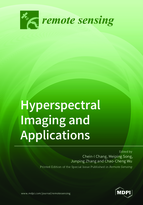Hyperspectral Imaging and Applications
A special issue of Remote Sensing (ISSN 2072-4292). This special issue belongs to the section "Remote Sensing Image Processing".
Deadline for manuscript submissions: closed (31 December 2017) | Viewed by 150189
Special Issue Editors
Interests: hyperspectral/multispectral image processing; medical imaging
Special Issues, Collections and Topics in MDPI journals
Interests: hyperspectral image processing; artificial intelligence; remote sensing
Special Issues, Collections and Topics in MDPI journals
Interests: hyperspectral/multispectral data analysis and processing; multisensor information fusion and applications; VHR image information extraction and interpretation; polarized hyperspectral image processing
Interests: hyperspectral/multispectral image processing and algorithm design; medical image processing; endmember extraction; target detection and identification
Special Issue Information
Dear Colleagues,
Due to advent of sensor technology, hyperspectral imaging has become an emerging technology in remote sensing. Many problems, which cannot be resolved by multispectral imaging, can now be solved by hyperspectral imaging, The aim of this Special Issue is to develop new ideas and technologies to facilitate the utility of hyperspectral imaging and to further explore its potential in various applications. This Special Issue is three-fold, focusing on:
- developing new ideas, techniques in the following topics of interest (but not limited to them):
- anomaly detection, target detection
- application to multispectral/hyperspectral imaging
- band selection, dimesnionality reduction, data compression
- compressive sensing, sparse representation, tensor decomposition
- unsupervised learning, active learning, deep learning
- data/sensor/information fusion
- endmember finding, extraction, variability
- high performance computing
- multispectral/hyperspectral image classification
- hyperspectral unmixing
- subpixel target analysis
- hyperspectral data visualization
- algorithm design, architecture, and implementation:
- real time processing
- parallel processing
- FPGA
- applications of hyperspectral imaging in remote sensing:
- agriculture including detection of diseases, pesticide residuals for produces and crops
- enviromental monitoring including toxic wastes, water pollution, oil spills and sewage
- food safety and inspection including fruit grading, vegetable and meat contamination
- forest and planatation including species detection and classification
- restoration of cultural relics
- medical imaging including partial volume estimation, lesion detection and tissue classification in magnetic resonance imaging
- reconnassaince including rescue and search, active target detection
- surveillance including passive target detection
Professor Chein-I Chang
Professor Meiping Song
Professor Junping Zhang
Professor Chao-Cheng Wu
Guest Editors
Manuscript Submission Information
Manuscripts should be submitted online at www.mdpi.com by registering and logging in to this website. Once you are registered, click here to go to the submission form. Manuscripts can be submitted until the deadline. All submissions that pass pre-check are peer-reviewed. Accepted papers will be published continuously in the journal (as soon as accepted) and will be listed together on the special issue website. Research articles, review articles as well as short communications are invited. For planned papers, a title and short abstract (about 100 words) can be sent to the Editorial Office for announcement on this website.
Submitted manuscripts should not have been published previously, nor be under consideration for publication elsewhere (except conference proceedings papers). All manuscripts are thoroughly refereed through a single-blind peer-review process. A guide for authors and other relevant information for submission of manuscripts is available on the Instructions for Authors page. Remote Sensing is an international peer-reviewed open access semimonthly journal published by MDPI.
Please visit the Instructions for Authors page before submitting a manuscript. The Article Processing Charge (APC) for publication in this open access journal is 2700 CHF (Swiss Francs). Submitted papers should be well formatted and use good English. Authors may use MDPI's English editing service prior to publication or during author revisions.
Keywords
- Band selection
- Endmember finding and extraction
- Multispectral/Hyperspectral image classification
- Hyperspectral unmixing
- Subpixel target and anomaly detection
- Hyperspectral applications







